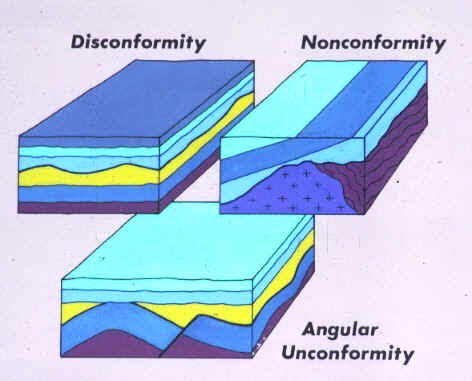 |
Earth History |
 |

 |
Earth History |
 |


THE LAW OF SUPERPOSITION
The method of placing rocks in their proper sequence of formation, from which formed first, second, third, etc. is relative dating. Relative dating is accomplished by using the law of superposition, the principle of original horizontality, inclusions, principle of cross cutting relationships, and unconformities.
The law of superposition was proposed by Nicolaus Steno in 1669. This simple rule states that in an undeformed sequence of rocks, each bed is older than the one above it and younger than the one below it.

ROCK LAYER DIAGRAM
The principle of original horizontality was also proposed by Steno. It simply states that layers of sediment are generally deposited in a horizontal position. When examining a rock outcrop, if the rock layers are flat, it means they have not been disturbed and the original horizontality is maintained.
The principle of cross cutting relationships applies to faults and igneous intrusions. Faults that cause a rock layer to break must have occurred after the rock layer was deposited. Similarly, igneous intrusions cannot cut across or disturb rock layers unless the rock layer was deposited before the intrusion occurred.

ROCK INCLUSION
Inclusions are fragments or pieces of one rock unit imbedded in another rock unit. It is easy to see that the inclusion must have existed before it was incorporated into the rock unit.

UNCONFORMITIES
Unconformities occurs over a long time period when sediment deposition has ceased, erosion removes the top rock layers, and then sediment deposition resumes. These geologic formations represent significant geologic events and help geologists determine what time intervals are missing from the geologic record. There are three types of unconformities. Nonconformities separate older metamorphic or intrusive igneous rocks from younger sedimentary strata. Angular unconformities are easy to recognize because sedimentary rock layers are tilted or folded and then overlain with younger, horizontal strata. More common, but more difficult to identify are disconformities. Disconformities occur in parallel strata where the rocks above and below the unconformity are quite similar.
Back to Earth History Page 1 |
Earth History Page 3 |
Go To Earth History Assignments |